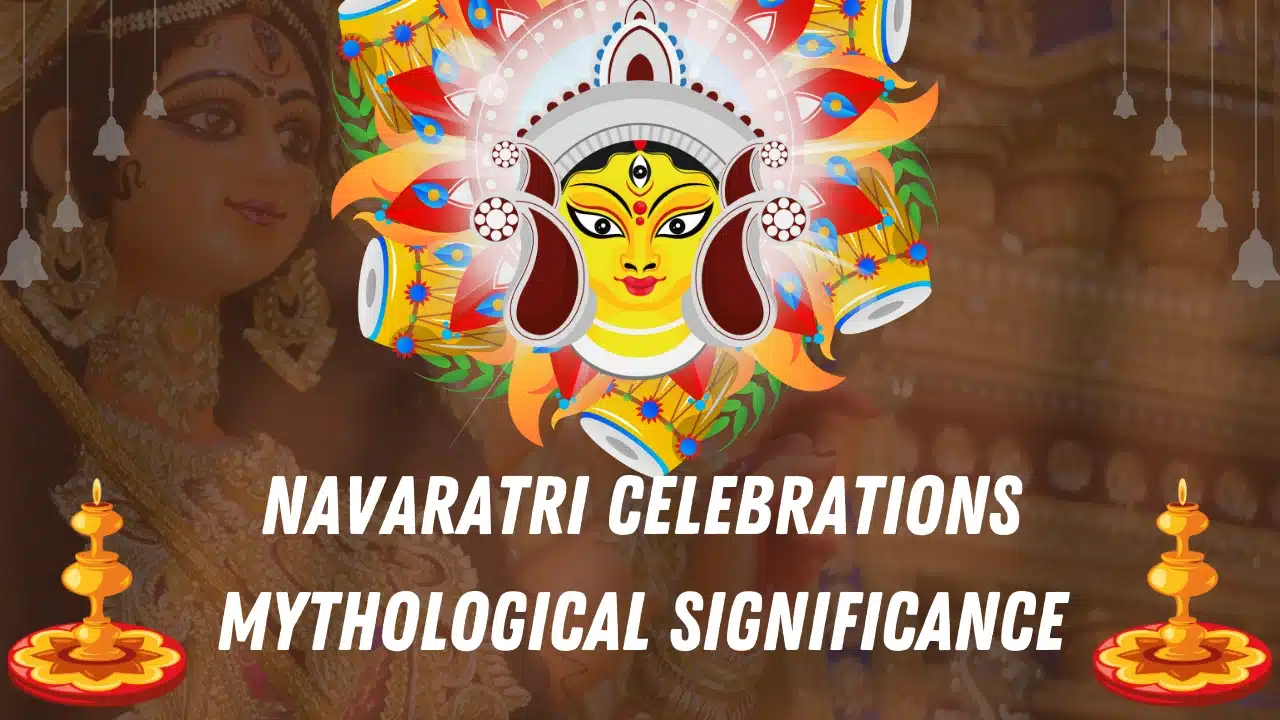- What is Navratri?
- Mythological Significance of Navratri
- Nine forms of Nava Durga
- Navratri Day 1 | Shailaputri
- Navratri Day 2 | Brahmacharini
- Navratri Day 3 | Chandraghanta
- Navratri Day 4 | Kushmanda
- Navratri Day 5 | Skandamata
- Navratri Day 6 | Katyayani
- Navratri Day 7 | Kalaratri
- Navratri Day 8 | Mahagauri
- Navratri Day 9 | Siddhidatri
- Navratri Day 10 | Dussehra Vs Vijayadasami
- Navratri Rituals Across India
- Gujarat
- Tamil Nadu
- West bengal
- Bihar
- Andhra Pradesh
- 9 Days activate 9 Chakras of the Human body
- Navratri Decoration Ideas
- Navratri Songs
- Final Thoughts
- FAQs
We all wait for the month of October and for good reason. One is the first set of Quarterly Holidays we get in school and the other one is Navratri celebration where every day is a filled with divinity. In my house, it is about the Golu, which I will talk about in a bit.
Let’s take this divine journey of exploring the Navratri celebration in depth along with some Navratri songs suggestions. With some additional tip of some Navratri decoration ideas. Shall we?
What is Navratri?
The significance of Navratri is derived from Sanskrit where ‘Nava’ means the number Nine and ‘Ratri’ means Night. So Navratri means Nine Nights which takes us to the story of how it was formed. Though the Navratri celebration happen through the lengths and breaths of India, each state celebrates it differently and for different reasons.
Mythological Significance of Navratri
The Navratri celebration is deeply rooted in mythology. The most revered mythology tells us the story of Maa Durga. Like many asuras (diabolical creatures), the buffalo headed Mahisasura ( pronounced as Mahi-sha-sura ) went on a penance and asked Shiva to be blessed with immortality, which is the only thing that even gods cannot grant. So they tweak their wishes and this particular demon asked for death that can be done only by a powerful woman.
Though he was granted the wish, he did not realise any woman being powerful-enough to defeat the notorious demon. When the asura went on a murdering spree and tarnished the Swargaloka (heaven in Hinduism), the devas who protect and reside in the surroundings went to the Trinity for help. They channelled their energy together to incarnate and evoke Maa Durga. She was given their powers to destroy the demon along with weapons of Indra and other celestial bodies to the battle that took place for 9 long days.
Nine forms of Nava Durga
She fights with the demon in different forms of Shakthi who finally becomes the Mahakali killing the demon triumphing good over evil. Let’s take a look at all the 9 Devis and their role in the festival
Navratri Day 1 | Shailaputri
Navratri celebration happened thoroughout 10 days. Pronounced as Shy-laa-puthri, she is the daughter of the mountains born to Himawat [Father of Himalayas]. Her mode of transport is a ferocious bull, who is none other than Nandhi. She is recognised by her spirit animal and the lotus in each hand along with Trishul that she holds.
She is the reincarnation of Sati, the daughter of King Dakshan and the wife of Lord Shiva. She dies when her father insults her husband and sacrifices herself on a whim to prove her innocence, falling into the holy fire only to be born as Parvati in the next birth.
As she is the first Devi worshipped during Navratri, she is called Adi Parashakthi just like her spouse who is considered as the Adi Purusha (meaning: the first human or male).
Shailaputri activates the Muladhara that is present in the tip of our spine starting Navratri in full swing, who blesses us with letting go of our ego or past and start your journey toward spiritual awakening marking the first day of Navratri.
The colour of the day would be yellow signifying happiness, hope and high spirits.
Navratri Day 2 | Brahmacharini
Legend says Bhramacharini learnt the art of abstinence, and indifference who is the virgin goddess desiring to marry Lord Shiva and no one else. She moves to Himalayas and performs a penance hoping Lord Shiva would change his mind despite her parents’ disapproval. She lives on by feeding on belpathra (a kind of leaf available in Himalayas) and the river water of Brahmaputra. Despite many coming in disguise, she refuses everyone including Lord Shiva who disguises himself as an old man asking riddles. However, when an asura tried to attack her with a million arrows, Lord Shiva rescues her and agrees to marry her.
She is recognised with a simple saree holding a japamala (a garland to count the number of chants in a penance or meditation) and a kamandalu (a vessel for holy water carried by the sages) in her hand. Brahma is the ultimate truth of the universe and acharini is the sanskrit word that means an occupation that one holds. So she is the beholder of the Universal Truth in a nutshell.
Brahmacharini invokes the spirit of our true awakening filled with self discipline, patience and strong willpower like Goddess Parvati kindling our Swadhisthana Chakra present in the belly button of the human body.
Wear shades of green on Day 2 of Navratri signifying the fertile land and growth in every possible way.
Navratri Day 3 | Chandraghanta
She is ferocious with 9 hands fighting demons in one hand and blessing her devotees in the other. She is recognised by the ghada (Mace), the Trishul (trident), lotus flowers, Ganta (bell) and Kamandal (a water bottle of the mythological days) accompanied by a crescent. She is always said to keep her third eye open unlike Lord Shiva.
Chandraghanta means the ‘bearer of half moon’ and her story is to find her inner power as Shakthi to destroy Jatukasura, the demon of evil bats, sent by Tarakasuran to attack the newly wed Parvarati. When she was in trouble while Lord Shiva was in penance, he reminded her of HER powers and asked her to fight her battle without HIM intervening. She fights the demons with a borrowed crescent light from the moon and Ghada demolishes the demons despite utter darkness. She rang the Ganta, a gong which vanished that earlier covered the entire sky with an army of bats.
Therefore, we pray for her to give us inner strength and courage to face every obstacle we encounter. Her story also proves gender is not an issue between Lord Shiva and Goddess Parvati – Girl Power!
Goddess Chandraghanta is connected to our Manipura radiating the power of controlling our inner beasts to walk the tedious path of Dharma (righteousness).
This day is about grey which is a mix of black and white teaching us to keep our emotional self in check.
Navratri Day 4 | Kushmanda
She is the lion riding goddess of eight hands and is said to have created the Universe with a flash of her smile. There was darkness when Suradev, the lord of Sun, a celestial body, went to earth mesmerised by the glowing bodies of Mali and Sumali burning them into ashes when he got too close.
This situation disrupted the universe’s balance. When Shiva incapacitated Suryadev with his trident, but later realised his mistake, HE asked Parvati to go in place of the sun who blooms into eternal sunshine in place of the Sun. Despite the curse of Rishi Kashyapa, she was able to rectify her spouse’s mess by filling a pot of the asura’s blood and the other one with nectar. She also gifted the birth of Kushma to Devavati, who is the mother of the asura’s sons. Finally, Kushma went in place of Suryadev.
Kushmanda’s etymology translates to Ku that means the one, ushma means heat and anda means a spherical structure resembling an egg. She is the core of the sun which gives energy to the entire universe.
Awaken your Anahata, the heart Chakra, on the fourth day of Navratri celebration by praying to Kushmanda, who radiates a glowing divine energy forming the core of the Sun. Her benevolent smile signifies unconditional love of the mother filled with empathy and compassion.
Orange is a colour of flamboyance and this is the colour you need to exuberate – a spirit filled with positivity.
Navratri Day 5 | Skandamata
As the name suggests, she is the mother of Skandha or Muruga as we know him. She is the four-handed mother who holds her six-headed infant, Karthikeya in one hand while holding Abhayamudra, a blessing position, on the other.The other two hands of the goddess is seen to have a lotus in each hand, sitting on a lion with an enchanting smile. The one who worships her with true devotion, is said to get blessed with prosperity. She is the ‘Fire Goddess’ who radiates light on earth like the Sun.
Skandamata is the goddess who takes care of your Vishuddha Chakra located in the throat who fills your thoughts with clear thoughts evoking knowledge while improving your communication skills.
Wear a white attire to showcase the tranquil nature of Skandamata defining purity and inner peace.
Navratri Day 6 | Katyayani
She is the first glimpse of the Kali we know manifested by the powers of many celestial bodies with crystalised energy rays made of anger outside Rishi Kayana’s abode. Hence, she was called as the sage’s daughter. She was born to kill the demonic activities of Mahishasura who fell for her beauty. When asked in hand, she asks him to fight her down to see his strength. When the asura shape shifted as a bull, she left her lion loose and rode the bull with fierce energy, took the asura’s head with the sword given by Kala along with the other weapons given by Shiva, Brahma, Vishnu, Indra, Agni, Vayu, Kuvera, and Vishwakarma to name a few. As she killed Mahishasura, she is also referred as Mahishasuramardhini.
Goddess Kayanani is celebrated on the sixth day residing in Agya or Ajna Chakra that is placed between one’s eyebrows where your third eye brightens with knowledge. She helps her devotees to see the big picture and kills your smaller fears that affect it.
Be the courageous Kali today by representing her with the colour of red symbolising passion, vigour and love.
Navratri Day 7 | Kalaratri
There are many legends around this donkey-riding goddess who looks threatening as she is the goddess of black (kala in Sanskrit), the one who bears the time of death which is also the abode of every being who attains salvation. She has lustrous black hair, spews fire every time she inhales and exhales, with three eyes that glisten like the rays of the sun.
One of the most famous stories involve the battle of Chandi in place of Parvati to fight the demons, Shumba and Nishumba when they tried to attack the Devaloka, a heaven of celestial bodies. She creates Kali, the goddess of darkness to kill the munda earning the name, Chamundi. She was however, challenged by the demon, Raktabija, who had the boon of reincarnating as clones with every drop of blood touching the ground. Kalaratri, furious by this act, drinks the asura’s blood who could stop the killing who destroys every in her sight. After many devas pray to Shiva to come to their rescue, He appears under her leg, making Kalaratri stop further murders and realise her mistake.
Goddess Kalaratri, the fiercest of Durgas resides in the lower muladhara chakra who is in between birth and death destroying the myth and the delusional world that we call reality.
Add a dash of panache to your 7th day of Navratri by twirling in striking royal blue stating salvation.
Navratri Day 8 | Mahagauri
The story of Mahagauri whose name translates to Great Brightness is a prequel of sorts. Mythology says she was teased by Lord Shiva as black who then prayed to Brahma to turn her dark complexion to golden. Though he refuses, when she takes bath in Ganges located in Himalayas, she looks at Devas who were praying to her to kill Shumba and Nishumba followed Raktabija. As they did not recognise her, she turns black becoming Kalika and then creates Chandi, explained in the story of Kalaratri.
She rides an ox back to Mt. Kailash where her family was waiting to get reunited after the battle. She is also called Mahasaraswathi who gives us the gift of knowledge. This is the reason we celebrate this day dedicated to knowledge and perform Sarawathi Puja, the only day we are all asked not to read or work!
Worship Goddess Mahagauri for the purest thoughts that are ego-less as she invokes the Crown Chakra that gives you a glimpse of liberation.
The colour of today will be all hues of pink showcasing the approachable mother-like Mahagauri filled with love and harmony.
Navratri Day 9 | Siddhidatri
She concludes the end of this tedious battle and thereby completes the exciting stories of Navratri depicting a Devi on each night. Siddhidatri is the Mahashakthi encompassing the entirety of the Universe. She gives birth to the Trinity of Hinduism, Shiva, Brahma and Vishnu giving them roles, responsibilities and respective wives to aid them to perform their duties. Sitting on a fully bloomed lotus, she is said to possess supernatural powers, otherwise called Siddhis including Anima, Mahima, Garima, Laghima, Prapti, Prakambya, Ishitva and Vashitva part from holding on to her majestic mace, Chakra (a spherical disk for Lord Visnu) and a Shankha (a conch shell from the deepest depths of the ocean).
She is said to remove the fear of ignorance only to reveal the path to great knowledge imparting true wisdom to her devotees, guiding them with the light of HER divine blessings.
On the 9th day, Siddhidhatri is worshipped who blesses her devotee’s upper Sahasrara, a jewel that is protected inside a lotus which is believed to be attained when the flower has blossomed completely. She is mystically divine blessing you with divinity to understand the beyond.
Take your Navratri celebration up a notch with purple themed attire to celebrate the noble goddess, Siddhidatri ending the 9-day celebration in style.
Navratri Day 10 | Dussehra Vs Vijayadasami
Though we call the festival Navratri, the dashami, the tenth day of Navratri celebration are Dussehra and Vijayadashami in North India and South India respectively.
In the north, the mythological significance of Navratri is Lord Rama killing the ten-headed Ravana for abducting Sita, celebrated as Dussehra (meaning: Ten Defeat).
The southern part of India celebrates it as Vijayadasami, one of my favourite days of Navratri.
Though schools will reopen a day after Vijayadasami, this is the day of new beginnings. I get to make new friends in my music class from childhood. Like me, many children start something new with admissions in preschool, learning a new instrument or anything that kid desires to learn from scratch. The next day however goes into last-minute holiday homework and helping our parents with the laborious task of dismantling the golu, and wrapping them back safe for the following year.
Some families start prepping for the next big festival, Diwali or Deepawali – the festival of lights as it is born 20 days after Vijayadasami.
Navratri Rituals Across India
Navratri is one festival that has depicted strong women who have thrived with power for ages that is celebrated by grand feasts, dance and celebratory ceremonies to Indian homes.
Gujarat
When you visit Gujarat during Dussehra you will see women and men in colourful attire dancing to Maa Durga songs in sync. Yes, I am talking about Garbas grooving through the night. On the 10th day, they immerse Maa Durga to save their livelihood in water bodies just like Ganapathy during Ganesh Chaturthi. Garbas come from the word Garbho, which means a clay pot which is worshipped all through the nine days believing that Shakthi lives in it.
Tamil Nadu
In the south, homes are decorated with Golu dolls and thematic decorations. Infact, in my culture and many south Indian homes, we decorate multiple steps with dolls representing different mythological tales. In today’s date, we have many modern depictions like IT conference rooms and the like. We make thematic decorations with fairy lights outlining the steps in multiples of three for nine days. We call our neighbours to visit our homes for Golu where three things matter the most – the theme, the song which we are mostly forced to sing in every home followed by a different sundal (a south Indian protein dish) each day along with a take-away gift.
West bengal
In western India, especially Bengal, the Durga Puja or Pujo as they call it, is celebrated in grandeur with special feasts all through Navratri celebration. Famous singers like Shreya Goshal and many sing their heart out in major concerts that enlighten the festive spirit.
Bihar
This state is considered as the native of Sita, where she was born. This spring festival worships her with elaborate fairs rich in culture, with a folklore theme. While Durga is worshipped in the beginning, the latter part of the festival celebrates Ravana Dahan where tall effigies are burnt as they do in most of north India commencing on the 10th day of Navratri.
Andhra Pradesh
Many parts of Andhra including Telangana, celebrate Bathukamma. A festival celebrated by women by decorating fresh flowers in 20 feet moulds depicting Goddess Gauri who brings strength and splendour to the society, is revered along with Goddess Saraswathi and Goddess Lakshmi. The word Bathukamma means the ‘Mother Goddess Come Back to Life’ where farmers thank her blessings for bringing prosperity and livelihood to their surroundings.
9 Days activate 9 Chakras of the Human body
There are many cultures that observe fasting. It does not only involve abstinence from grains and non-vegetarian cuisine but also from every sin. People try to keep their mind, body and soul clean which resets it for the rest of the year involving the process of detoxification, mindfulness and self-discipline.
All the Devis invoked during Navratri are said to depict a certain chakra as said in the scriptures
Navratri Decoration Ideas
Let’s take a look at some of the easiest Navratri Decoration Ideas ways to add eco-consciousness to your festive vibe.
Some of the easiest ways to bring the theme of the day is to add painted diyas for each day with innumerable flora and fauna you can find in your garden.
Make a poo-kolam, a unique arrangement of flowers in designs and patterns (mostly concentric circles) adding a vibrant welcome.
Add handmade lanterns to add the right hue on each day. I recommend you to buy eco-friendly dolls made of mud that will give your decor an earthy outlook while dissolving into water without deteriorating the water bodies with its chemical painted counterparts available in the market.
Take away gifts can be planting starter kits that kids can grow without any fuss. Handing seed thank you notes is also an option to plant a surprise seedling yielding happiness.
If you are having a Golu, make parks and other thematic innovations with simple things like fairy lights and sieved sand instead of wasting your hard-earned money in one festival while Diwali is fast approaching!
Navratri Songs
You Navratri playlist completely depends on your culture. If you are a Gujju, listen to the multiple albums of Falguni Pathak, the famous O Sherowali, or the Mataji Ni Aarti (Garbe Ghumjo Raaj). Some of the film Navratri songs that resonate the Garba spirit including Jhume Re Gori from Gangubai Kathiawadi, Shubhaarambh from Kai Po Che and Nagada Sang Dhol from Ram Leela.
In South India, kids sing navratri songs that praise Goddess Durga. Most of them are Carnatic Keerthanas or bhajans. Some of the famous ones include Durga Lakshmi Saraswathi, or Akhilandeshwari in Dwijavandhi raga, Naan Oru Vilayaatu Bommaiya in the raga Navarasa Kannada or Mahalakshmi Jaganmatha. There are tough and easy navratri songs to learn based on your level of expertise.
In some households slokas like aigiri Nandhini go on loop all through the day to bring the festive spirit alive apart from keeping a good vibe in the house.
Final Thoughts
There are innumerable festivals in India with a variety of cultures coming together to win over the gracious blessings of Maa Durga. We hope you have started working on your decor already, building make-shift steps for your golu or fetching garba passes from your friends in your city.
Don’t forget to sign up for our online music classes on Vijayadasami to learn the art of music with age no bar.
FAQs
What is Navratri?
Navaratri is the 9-day festival celebrated annually across India praising nine different Devis.
When is Navratri celebrated?
Navaratri generally commences between the third week of September or the first two weeks of October in any given year.
Why is Navratri celebrated?
Navaratri is celebrated for two main reasons - one is the number of days Rama took to find his abducted wife, Sita, from the evil hands of Ravana. Another version was Maa Durga being invoked by celestial beings to kill the evil demon, Mahishasuran, after a battle that lasted for 9 days.
How to celebrate Navratri at home?
The way you celebrate Navaratri at home depends on your culture. Ideally, we would recommend you to have vibrant entrances with fresh flower decorations, festive treats, and take away gifts to fulfil its purpose.
What are the nine forms of Goddess Durga?
The nine forms of Goddess Durga include Shailaputri, Brahmacharini, Chandraghanta, Kushmanda, Skandamata, Katyayani, Kalaratri, Mahagauri and Siddhidhatri celebrated on each day of Navaratri.
What is the significance of fasting during Navratri?
Fasting during Navaratri brings blessings in abundance while teaching you the importance of self discipline obtained through abstinence.
What are the traditional foods for Navratri?
As many people follow fasting during this season, dishes made from Sabudana, wheat, fresh fruits and selected vegetables excluding the ones grown underground like potatoes, beetroot and the like make your typical thali. South Indians abstain from grains and non-vegetarian food,
What is the story behind Navratri?
The story behind Navaratri is good triumphing evil. Whether it is Rama’s victiry over Ravana or Maa Durga’s winning the holds of Mahishasura, the spirit of the festival remains the same for centuries together.
Related blog: Theeratha Vilayattu Pillai































